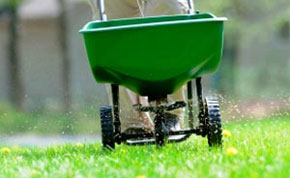Don’t Be In A Hurry To Fertilize Your Lawn
March 6, 2010
Warmer weather is arriving, but don’t be in a hurry to fertilize your lawn — that’s the word from the University of Florida IFAS Extension office.
Even though it is still winter, now is the time of year that local garden centers begin major advertising campaigns to sell lawn fertilizers. It is too early to fertilize your lawn.
Fertilize when the lawn is actively growing
 Warm-season lawns, including St. Augustinegrass, zoysiagrass, and centipedegrass go dormant in winter in Northwest Florida. Fertilizing now would be a waste of time and money. Why shouldn’t you fertilize warm-season grasses when they are dormant? First, when grasses are dormant, their roots are not able to absorb or use the nutrients from fertilizers. By the time the grass does begin actively growing, most of the nitrogen you applied will have been lost from the soil. A safe time to apply your first lawn fertilizer is around April 15th.
Warm-season lawns, including St. Augustinegrass, zoysiagrass, and centipedegrass go dormant in winter in Northwest Florida. Fertilizing now would be a waste of time and money. Why shouldn’t you fertilize warm-season grasses when they are dormant? First, when grasses are dormant, their roots are not able to absorb or use the nutrients from fertilizers. By the time the grass does begin actively growing, most of the nitrogen you applied will have been lost from the soil. A safe time to apply your first lawn fertilizer is around April 15th.
Don’t feed the weeds
Fertilizing while the grass is dormant actually encourages more winter weeds, because you are fertilizing the weeds instead of the lawn. Without competition from the lawn, these weeds will grow faster and become more prolific as a result of dormant fertilizer applications.
Lastly, fertilizing lawns during their transition into dormancy in the fall or out of dormancy in the spring may encourage lawn growth that is more likely to be injured from winter kill. Bare spots and thinning of the lawn as well as delay in spring green-up may occur when lawns are forced to grow when they should be dormant.
Combo products not the answer
 Many of the products available are convenient “weed and feed” products that combine a pre-emergent herbicide and fertilizer in one application. Unfortunately, the ideal time to apply a pre-emergent herbicide is very different than the ideal time to apply fertilizer for warm-season lawns.
Many of the products available are convenient “weed and feed” products that combine a pre-emergent herbicide and fertilizer in one application. Unfortunately, the ideal time to apply a pre-emergent herbicide is very different than the ideal time to apply fertilizer for warm-season lawns.
In northwest Florida, the recommended application window to maximize the effectiveness of preemergent herbicides is typically between February 15 and March 5.
The application timing for these products is critical since they must be applied before summer annual weeds germinate in spring. It’s always better to apply preemergent herbicides a little earlier rather than too late. And don’t forget to activate them by watering them into the lawn.
For St. Augustine grass, centipede grass, and other warm-season grasses, buy fertilizer that is separate from the pre-emergent herbicide. Apply each at their recommended times.
Finding a separate pre-emergent herbicide, not in weed-n-feed form, may be difficult. Some ones to look for include: benefin (Sta-green Crabgrass Preventer, Hi-Yield Crabgrass Preventer), pendimethalin (Pre-M, Pendulum, Turf Weedgrass Control, Halts Crabgrass Preventer), and bensulide (Green Light Betasan Crabgrass Preventer).
Start with a soil test
A soil test is always a good starting point before investing in fertilizer or lime. Your local University of Florida County Extension office can help you get started.
Theresa Friday is the Residential Horticulture Extension Agent for Santa Rosa County.
Comments
7 Responses to “Don’t Be In A Hurry To Fertilize Your Lawn”



Ok,
so here it is 8 Apr and Ivet done nothing is it too late anything I can do now to weed or fertilize my messy lawn? thx
I forgot to put down the pre-emergent! Is there anything I can do now to stop the weeds?
Good to know. We moved into the area over the winter and I was thinking I should fertilize the St Augustine soon. Today is Feb 18 so instead I will treat with a pre-emergent herbicide.
BTW, what is a good or best fertizer type or brand for NW FL Panhandle?
Short and to the point, very informative. Thanx!!
Thank you very much for this information. I almost made the mistake of fertilizing my lawn.
Thank you for this information.
Thanks! Very useful information.